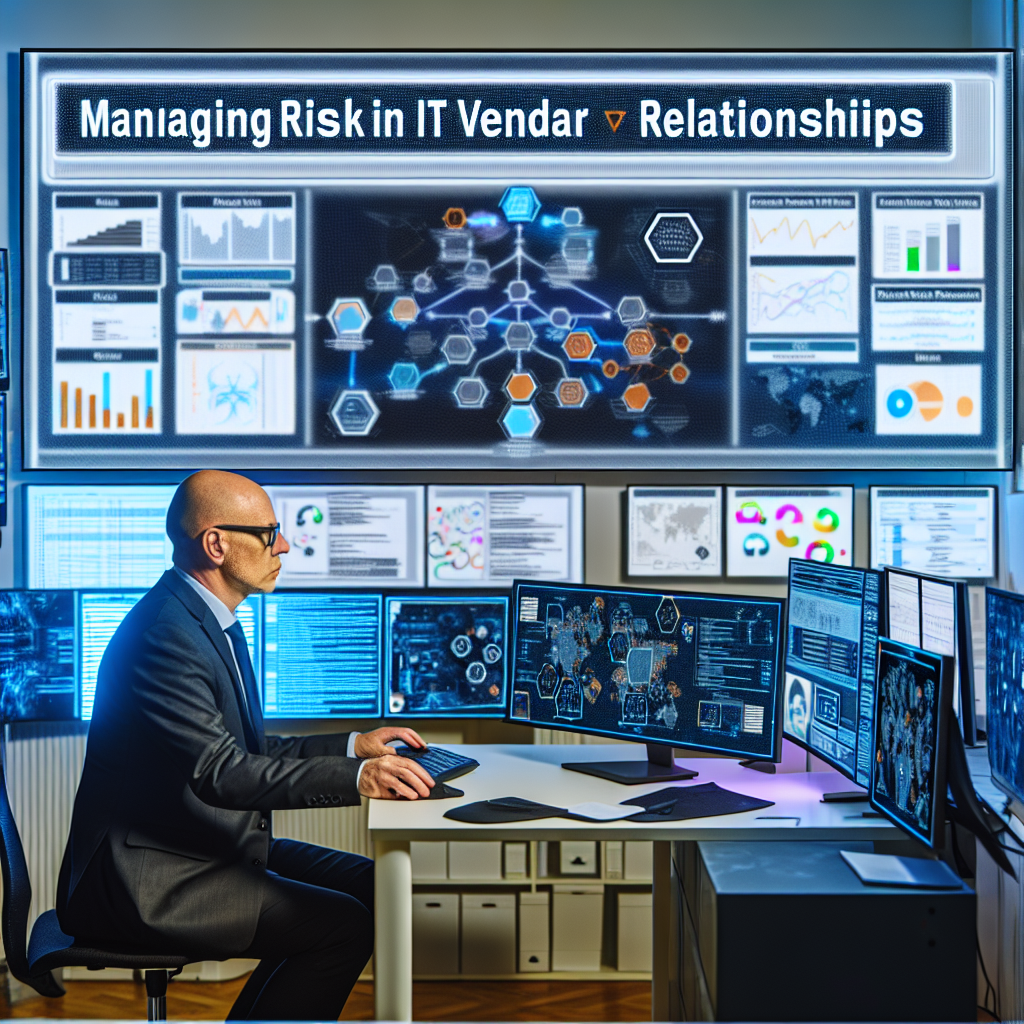Introduction
Risk assessment in IT vendor management involves identifying and analyzing potential risks associated with third-party vendors.
This process helps organizations protect their data, assets, and operational integrity.
In an era where companies depend heavily on external partners, understanding these risks becomes critical.
In today’s digital landscape, effective risk assessment is more important than ever.
Cyber threats, data breaches, and compliance violations can arise from vendor relationships.
With organizations increasingly outsourcing key functions, recognizing these risks can safeguard against substantial financial and reputational damage.
This blog post aims to enlighten readers about the importance of effective risk assessments.
It will outline various steps and strategies to enhance vendor management processes.
By the end of this post, readers will understand how to implement robust risk assessments, ensuring better decision-making when selecting and managing IT vendors.
Effective Vendor Management for IT Organizations
Effective vendor management is crucial for IT organizations.
Vendors can introduce various risks that can threaten organizational integrity.
Understanding these risks helps businesses implement effective countermeasures.
This section explores the common risks associated with IT vendors, highlights relevant case studies, and emphasizes the consequences of these risks.
Overview of Common Risks
IT vendors present several categories of risks.
Identifying these risks is essential for early mitigation.
The most common risks include:
- Security Risks: These involve unauthorized access to data and systems.
- Compliance Risks: Vendors may not adhere to regulations affecting your organization.
- Performance Risks: Vendors might not deliver services consistently or adequately.
Organizations often assume that their vendors follow industry best practices.
However, security lapses can occur.
The failure to implement security measures can lead to significant breaches.
Security Risks
Security risks primarily involve data breaches.
Transform Your Career Today
Unlock a personalized career strategy that drives real results. Get tailored advice and a roadmap designed just for you.
Start NowVendors may have weaker security practices than your organization.
This disparity creates vulnerabilities.
Additionally, third-party access can expose sensitive customer data.
Consider a case where a cybersecurity firm suffered a breach.
The breach occurred due to a vendor using outdated software.
Hackers accessed customer data, leading to reputational damage and financial loss.
Such events underscore the necessity for robust vendor security assessments.
Another common scenario is the risk of ransomware attacks.
A vendor’s system may get compromised and affect your organization.
If a vendor’s security measures fail, your systems may also fall victim to attacks.
Regular monitoring is essential to assess vendor security practices.
Establishing communication about security protocols mitigates these risks.
Companies must validate that vendors comply with established security frameworks.
Compliance Risks
Compliance risks often arise from regulatory frameworks.
Vendors must comply with rules such as GDPR, HIPAA, or PCI DSS.
Failure to follow these regulations can result in hefty fines for your organization.
For example, a healthcare organization faced penalties because a third-party provider mishandled protected health information.
The healthcare company did not adequately vet the vendor’s compliance practices.
This incident highlights the need for thorough due diligence.
Showcase Your Business Today
Reach thousands of readers actively exploring professional services. Publish your business profile and grow your audience now.
Publish NowOrganizations must conduct background checks to ensure compliance adherence.
Contractual agreements must specify compliance expectations to safeguard against violations.
Performance Risks
Performance risks relate to the reliability of vendor services.
Vendors may not meet service level agreements (SLAs).
This non-compliance can disrupt operations, impacting end-users and customers.
For example, a cloud service provider may experience outages.
This can lead to significant downtime for businesses relying on those services.
The lack of communication during downtime can further exacerbate the negative impact.
To manage performance risks, companies should establish clear SLAs.
Regular performance reviews can identify shortcomings promptly.
Introducing penalties for non-compliance can incentivize vendors to meet their commitments.
Case Studies of Security Breaches Connected to Vendor Shortcomings
Several high-profile security breaches illustrate the consequences of vendor shortcomings.
Here are some pertinent examples:
- Target Corporation: In 2013, attackers exploited a vendor’s access to Target’s systems. They stole credit card details from millions of customers. This incident highlighted the importance of securing third-party vendor access.
- Equifax: In 2017, Equifax suffered a massive data breach. A vendor did not apply necessary security patches. The breach affected over 147 million individuals.
- Panasonic: In 2021, Panasonic fell victim to a cyberattack due to a third-party vulnerability. The attackers accessed critical systems, causing significant operational disruption.
Each of these cases underscores the profound impact of inadequate vendor risk management.
The subsequent financial losses and reputational damage were compounded by the lack of effective oversight.
Organizations must learn from these incidents to enhance their risk assessment strategies.
The Impact of Third-Party Risks on Organizational Integrity
Third-party risks directly impact organizational integrity.
A security breach can undermine customer trust.
When clients lose faith in your organization, long-term relationships may suffer.
This erosion of trust can lead to decreased revenue and market share.
Moreover, compliance failures can tarnish brand reputation.
Public perception is crucial.
Companies must demonstrate their commitment to security and compliance.
When stakeholders perceive weaknesses, they may reconsider partnerships and investments.
Additionally, performance issues can create internal strife.
If a vendor fails to deliver, internal teams may become frustrated.
This can lead to decreased morale and productivity across the organization.
Mitigating these risks requires a proactive approach.
Regular assessments of vendors can identify vulnerabilities before they become critical.
Organizations must foster open communication channels with vendors, encouraging transparency about risks.
By prioritizing these assessments, organizations can safeguard their integrity and maintain customer trust.
Establishing a Risk Assessment Framework
Creating an effective risk assessment framework is essential for managing IT vendor risks.
A robust framework helps organizations identify, evaluate, and mitigate risks associated with vendors.
By streamlining these processes, organizations can enhance their security posture and business continuity.
Key Components of an Effective Risk Assessment Framework
An effective risk assessment framework comprises several key components.
Each element plays a critical role in ensuring comprehensive risk evaluation and management.
The essential components include:
- Identification of Risks: Start by identifying potential risks linked to IT vendors.
- Risk Evaluation: After identifying risks, evaluate their potential impacts.
- Risk Mitigation Strategies: Develop strategies to mitigate identified risks.
- Monitoring and Review: Establish ongoing monitoring processes for assessing vendor risks.
- Documentation and Reporting: Maintain comprehensive records of all risk assessment activities.
Roles and Responsibilities of Stakeholders in Risk Assessment
To ensure a successful risk assessment framework, it is crucial to define roles and responsibilities clearly.
Various stakeholders contribute to the risk management process.
Their involvement enhances the effectiveness of risk assessments.
Showcase Your Business Today
Reach thousands of readers actively exploring professional services. Publish your business profile and grow your audience now.
Publish NowThe key roles usually include:
- Risk Management Team: This team initiates and oversees the risk assessment process.
- IT Security Specialists: These specialists analyze risks related to technology and data security.
- Legal and Compliance Officers: These professionals ensure that vendor contracts comply with laws and regulations.
- Procurement Officers: Procurement officers evaluate vendors based on risk assessments.
- Executive Management: The executive team provides strategic direction for risk management initiatives.
Tools and Methodologies for Conducting Risk Assessments
Employing the right tools and methodologies streamlines the risk assessment process.
A variety of tools can enhance the efficiency and accuracy of risk assessments.
Here are some tools and methodologies to consider:
- Risk Assessment Software: Various software solutions assist in streamlining the risk assessment process.
- Frameworks and Standards: Adopt established frameworks like NIST, ISO 27001, or FAIR.
- Risk Matrices: A risk matrix visually represents the likelihood and impact of risks.
- Vulnerability Scanning Tools: Use vulnerability scanning tools to identify weaknesses in vendor systems.
- Surveys and Questionnaires: Develop targeted surveys to assess vendor compliance and risk posture.
- Interviews and Workshops: Conduct interviews with key stakeholders and vendors.
Establishing a risk assessment framework is vital for effective IT vendor management.
By identifying risks, evaluating them, and implementing mitigation strategies, organizations can protect valuable assets.
Clearly defined roles ensure accountability in the risk management process.
Utilizing appropriate tools and methodologies enhances the efficiency of risk assessments.
The commitment to ongoing monitoring and review will ensure that risk management efforts remain relevant in a dynamic vendor environment.
Ultimately, a comprehensive risk assessment framework empowers organizations to make better decisions regarding their IT vendors.
It enhances risk awareness across the organization and enables a proactive approach to vendor management.
By dedicating resources and effort to this framework, organizations strengthen their resilience against potential IT vendor risks.
Discover More: Tech Evangelist’s Role in Product Feedback and Improvement
Identifying and Evaluating IT Vendors
Identifying and evaluating IT vendors is a critical component of effective risk assessment.
The selection process can influence not only project outcomes but also organizational security.
Therefore, organizations need to approach vendor selection methodically.
Criteria for Selecting IT Vendors Based on Risk Profiles
Determining criteria for selecting IT vendors requires a thorough understanding of risk profiles.
Each potential vendor poses unique risks based on their operations.
Here are some essential criteria to consider:
- Financial Stability: Assess the vendor’s financial health. Look for financial statements, revenue trends, and profitability.
- Reputation: Research the vendor’s market reputation. Seek reviews, testimonials, and case studies from other clients.
- Compliance: Ensure the vendor complies with relevant regulations. Check if they meet industry standards such as GDPR or HIPAA.
- Security Measures: Evaluate their security protocols. Ask about data protection measures and cybersecurity best practices.
- Experience: Consider the vendor’s experience in the relevant industry. Look for expertise with similar projects.
- Service Level Agreements (SLAs): Review their SLA terms. Ensure they align with your organization’s expectations and requirements.
By utilizing these criteria, organizations can form a comprehensive risk profile for potential vendors.
This helps in identifying which vendors may present higher risks and which ones are safer choices.
Importance of Due Diligence in the Vendor Selection Process
Due diligence is a vital step in the vendor selection process.
It involves thoroughly investigating a potential vendor before making a commitment.
Conducting due diligence minimizes risks significantly.
Here’s why it matters:
- Uncover Hidden Risks: Vendors may not disclose all risks upfront. Thorough investigations often reveal overlooked vulnerabilities.
- Legal Compliance: Vendors must adhere to legal regulations. Due diligence ensures they comply with necessary laws and standards.
- Operational Continuity: Assessing a vendor’s operational processes ensures they can deliver services reliably. This continuity impacts your organization’s functionality.
- Alignment with Business Objectives: Vendors should align strategically with your goals. Understanding their business philosophy and strategies increases the chances of a beneficial partnership.
Incorporating due diligence helps create a foundation of trust.
This trust is crucial for a long-lasting vendor relationship.
Furthermore, it enables organizations to identify red flags early in the process.
Best Practices for Evaluating Vendor Qualifications and Stability
Evaluating vendor qualifications and stability requires a structured approach.
Implementing best practices can significantly enhance this evaluation process.
Here are some recommended practices:
- Request Documentation: Always request key documents, such as financial statements, licenses, and certifications. This information helps evaluate their legitimacy.
- Conduct Interviews: Schedule interviews with vendor representatives. These conversations can reveal insights about their culture and responsiveness.
- Use Scoring Models: Develop scoring models for quantitative assessments. This structured approach provides an objective comparison of vendors.
- Reference Checks: Always conduct reference checks with current and former clients. Ask about their experiences regarding reliability and support.
- Explore Partnership Trends: Understand the vendor’s relationship dynamics with other clients. Stable relationships often point to vendor reliability.
Using these best practices allows organizations to evaluate vendor qualifications holistically.
This comprehensive evaluation significantly reduces risks.
It also lays the groundwork for successful vendor management moving forward.
Engaging in Continuous Monitoring
Evaluating vendors does not end once a contract is signed.
Continuous monitoring is essential for sustained risk assessment.
Below are several strategies to ensure continuous monitoring:
- Regular Performance Reviews: Schedule performance reviews to assess vendor services against expectations. This measurement ensures accountability.
- Establish Key Performance Indicators (KPIs): Define KPIs to quantify vendor performance. Regularly assess their ability to meet these indicators.
- Feedback Mechanisms: Implement feedback channels to gather insights from internal teams regarding vendor performance. This process helps in real-time assessment.
- Update Risk Profiles: Regularly update vendor risk profiles based on ongoing evaluations. This ensures that emerging risks are identified promptly.
- Maintain Open Communication: Foster transparent communication with vendors. Addressing issues early can prevent them from escalating.
Continuous monitoring creates a proactive approach to IT vendor management.
Organizations can adjust their strategies in response to changing conditions.
This adaptability is essential for a resilient vendor management program.
Showcase Your Business Today
Reach thousands of readers actively exploring professional services. Publish your business profile and grow your audience now.
Publish NowStrategies for Effective IT Vendor Management
Properly identifying and evaluating IT vendors is crucial for effective risk assessment.
By establishing standardized criteria and conducting thorough due diligence, organizations can make informed decisions.
Implementing best practices enhances the evaluation process significantly.
Continual monitoring ensures relationship dynamics remain positive and aligned.
Ultimately, these strategies lay a robust foundation for IT vendor management.
Uncover the Details: IT Compliance Analyst: Pros and Cons of the Role
Techniques for Ongoing Risk Monitoring
Continuous risk monitoring forms the backbone of robust vendor management.
Employing the following techniques can help organizations keep a close eye on vendor performance and associated risks:
- Regular Audits: Schedule and conduct regular audits on the vendor’s operations, compliance, and security protocols. Audits provide an objective review of vendor practices and help identify any gaps in performance or compliance.
- Performance Evaluations: Implement formal performance evaluations based on mutually agreed-upon key performance indicators (KPIs). These evaluations assess whether the vendor meets specified criteria, enhancing accountability.
- Risk Rating Systems: Establish a risk rating system to categorize and assess the risk level of each vendor. A structured rating allows organizations to prioritize their focus on higher-risk vendors.
- Contractual Review: Regularly review contracts and service level agreements (SLAs) with vendors. Ensure that all terms remain relevant, updated, and adhered to throughout the collaboration.
- Data Monitoring Tools: Leverage data analytics and monitoring tools to track vendor activities and performance in real-time. These tools can flag anomalies that may indicate rising risk levels.
Importance of Regular Communication and Collaboration with Vendors
Effective communication forms the cornerstone of risk management in vendor relationships.
Regular interaction with vendors enhances trust and accountability.
Consider the following best practices for maintaining open lines of communication:
- Establish Clear Channels: Define clear communication channels for regular updates, questions, and feedback. Both parties should know how to reach each other effectively.
- Regular Check-ins: Schedule regular check-in meetings to discuss ongoing projects, performance issues, and any changes in the vendor’s environment. Frequent interaction helps build rapport.
- Share Risk Insights: Share any risk insights and assessments with the vendor. Transparency fosters a collaborative atmosphere where both parties can work together on risk management.
- Open Feedback Loops: Create an environment for open feedback. Encourage vendors to provide feedback on processes, expectations, and their own challenges.
- Crisis Communication Plans: Develop a crisis communication plan to address emergencies or unforeseen problems. Make sure both parties understand their roles in these situations.
Strategies for Managing Identified Risks and Mitigation Planning
Identifying risks is just the first step; organizations must implement effective strategies to manage these risks.
Here are some approaches to consider:
- Risk Mitigation Plans: Develop clear, actionable risk mitigation plans for each identified risk. Outline steps that both the organization and vendor will take to reduce risks effectively.
- Contingency Planning: Create contingency plans for critical risks that could impact operations. Outline alternative courses of action if identified risks occur.
- Collaborative Risk Management: Involve vendors in the risk management process. Their insights can provide valuable perspectives on the challenges they face and how to address them.
- Documentation and Tracking: Maintain documentation of all risks and the actions taken to mitigate them. Tracking progress aids in accountability and can provide lessons learned for the future.
- Training and Awareness: Conduct training sessions on risk management for relevant staff members. Ensure your team understands the importance of monitoring vendor risks.
Monitoring and managing risks throughout the vendor lifecycle is an ongoing commitment that requires vigilance and collaboration.
By employing structured monitoring techniques, fostering strong communication, and implementing robust risk management strategies, organizations position themselves to navigate the complexities of vendor relationships.
Risk management does not end once a vendor is selected; it evolves as the relationship develops.
Adopting these practices not only safeguards the organization but also contributes to a more resilient and effective partnership with vendors.
As risks continually evolve, remaining alert and proactive is essential.
Organizations must adapt and refine their strategies to keep pace with emerging risks.
Building a culture of collaboration and accountability with vendors ensures that both parties can thrive amidst uncertainties.
By making risk management an integral part of vendor discussions, companies can significantly enhance their overall vendor management strategy.
Gain More Insights: Best Practices for Data Encryption and Protection

Understanding Industry Regulations Affecting IT Vendor Management
Effective IT vendor management must consider compliance and regulatory obligations.
Organizations must navigate complex regulations that shape their practices.
Industry regulations often influence how data is handled, stored, and processed.
Familiarity with these regulations is crucial for successful vendor partnerships.
Several key regulations impact IT vendor management.
Understanding these regulations helps organizations mitigate risks and avoid penalties.
Here are some major regulations to consider:
- General Data Protection Regulation (GDPR): This regulation governs data protection and privacy in the European Union (EU) and the European Economic Area (EEA). It imposes strict requirements for processing personal data.
- Health Insurance Portability and Accountability Act (HIPAA): This U.S. law outlines requirements for protecting medical information. Organizations in the healthcare industry must ensure compliance when working with vendors.
- Federal Information Security Management Act (FISMA): This U.S. law requires federal agencies to secure their information systems. It extends requirements to certain contractors and vendors.
- Payment Card Industry Data Security Standard (PCI DSS): This set of requirements governs the handling and processing of credit card information. It affects all vendors that deal with payment card transactions.
- California Consumer Privacy Act (CCPA): This law enhances privacy rights for California residents. Organizations must understand its implications when dealing with California-based vendors.
Organizations must develop strategies that address the requirements of these regulations.
Failing to comply can lead to significant financial penalties and reputational damage.
Best Practices for Ensuring Compliance with Data Protection Laws
Compliance with data protection laws requires a proactive approach.
Organizations need to adopt best practices that ensure adherence to regulations.
Consider implementing the following best practices:
- Conduct regular risk assessments: Assess vendor-related risks regularly. Identify compliance gaps and address them promptly. This practice creates a culture of ongoing vigilance.
- Establish clear vendor selection criteria: Set criteria that prioritize vendor compliance. Evaluate potential vendors based on their regulatory standing. Ensure they can demonstrate compliance with relevant laws.
- Implement robust contracts: Develop contracts with clear compliance obligations. Specify security measures, data handling protocols, and breach notification requirements. This practice protects your organization legally.
- Provide compliance training: Train employees on regulatory requirements. Ensure they understand their roles in maintaining compliance. Training raises awareness about data protection policies.
- Implement data encryption: Encrypt sensitive data to protect it from unauthorized access. Risk mitigation through encryption can be a critical compliance measure. Encryption acts as a safeguard against potential breaches.
- Regularly review vendor performance: Conduct performance reviews of vendors. Assess their compliance with contractual obligations. Continuous monitoring ensures accountability and adherence to regulations.
Applying these best practices facilitates a proactive compliance posture.
Organizations can effectively meet regulatory requirements while minimizing risks.
The Role of Documentation and Reporting in Compliance Efforts
Documentation and reporting play vital roles in achieving compliance.
Organizations must maintain clear records of their vendor management processes.
This documentation demonstrates due diligence in compliance efforts.
Key types of documentation include:
Showcase Your Business Today
Reach thousands of readers actively exploring professional services. Publish your business profile and grow your audience now.
Publish Now- Vendor risk assessments: Maintain records of risk assessments conducted on vendors. These records should detail risks identified and mitigation strategies deployed.
- Compliance audits: Document the results of compliance audits. Include findings, corrective actions taken, and timelines for implementation. This information demonstrates an organization’s commitment to compliance.
- Training records: Keep records of training sessions conducted for employees. Include agendas, attendance logs, and materials used. This documentation can provide evidence during audits.
- Contractual agreements: Retain copies of all vendor contracts. Ensure contracts contain clauses related to compliance and data protection obligations.
- Incident reports: Document any incidents involving vendor compliance failures. Include details about the nature of the incident, response actions, and lessons learned.
Regular reporting is also crucial in compliance efforts.
Organizations should establish reporting mechanisms to communicate vendor compliance status.
Regular compliance reports should include:
- Compliance metrics: Identify and track specific compliance metrics. This can include the number of compliance incidents, audit results, and training completion rates.
- Risk management progress: Provide updates on risk management activities. Detail actions taken to mitigate risks associated with vendors.
- Vendor performance evaluations: Summarize findings from vendor performance assessments. Highlight areas of non-compliance and actions required for improvement.
- Regulatory changes: Report any changes in regulations affecting vendor management. Ensure the organization remains informed and responsive.
Effective documentation and reporting not only ensure compliance but also facilitate informed decision-making.
Organizations can make better vendor management choices by leveraging this information.
Discover More: Implementing Real-Time Data Warehousing Solutions
In today’s fast-paced digital landscape, leveraging technology is crucial for effective risk assessment in IT vendor management.
Organizations face increasing risks that can derail business objectives.
Therefore, investing in the right tools and software becomes paramount in streamlining vendor risk assessments.
Overview of Tools and Software for Effective Risk Assessment
Many tools and software solutions help organizations conduct thorough risk assessments.
These systems automate processes, store data securely, and provide insightful analyses.
Below are some categories of tools commonly used:
- Risk Management Software: These tools centralize risk data management, allowing companies to visualize potential risks easily. They include features such as risk scoring and reporting templates.
- Cybersecurity Solutions: Firewalls, intrusion detection systems, and endpoint protection tools identify and mitigate cyber threats posed by vendors.
- Compliance Management Tools: These solutions ensure that vendors comply with regulations, such as GDPR or HIPAA. They help maintain compliance documentation and alert organizations of potential compliance risks.
- Data Analytics Platforms: These platforms help users assess vendor data comprehensively. They turn raw data into valuable insights by employing advanced analytical tools and algorithms.
- Project Management Software: Tools like Asana, Trello, or Jira can help track vendor-related tasks and issues, ensuring that risk management aligns with broader project goals.
Selecting the right tools based on organizational needs is essential.
Companies should assess their specific risk environment, the complexity of their vendor landscape, and budget constraints.
Benefits of Automation in Vendor Risk Management
Automation significantly enhances vendor risk management processes.
It reduces manual errors, speeds up assessments, and ensures consistency in evaluations.
Some key benefits of automation include:
- Increased Efficiency: Automated risk assessments save time and resources. They reduce the time employees spend on repetitive tasks.
- Consistent Evaluations: Automation standardizes assessments, ensuring all vendors receive the same scrutiny. This consistency improves reliability and fosters better decision-making.
- Faster Response Times: Automated alerts and reporting systems notify managers of potential risks quickly. This swift response helps organizations address issues before they escalate.
- Better Data Management: Automated systems organize and archive vendor risk data efficiently. This access to historical data allows organizations to examine trends and make informed decisions.
- Cost Savings: By reducing manual labor and increasing productivity, automation leads to significant cost savings. Organizations can allocate resources more effectively.
Organizations should recognize these advantages and actively seek to integrate automation in their vendor risk management processes.
How to Integrate Risk Management Tools with Existing Systems
Implementing new risk management tools requires careful planning to avoid disruptions.
Integration is essential for smooth operations.
Here’s how organizations can successfully integrate risk management tools with existing systems:
- Assess Compatibility: Before selecting a tool, assess its compatibility with existing systems. Able integration minimizes technical issues and enhances functionality.
- Define Objectives: Clearly outline the goals of the integration. Knowing what the organization aims to achieve ensures focused efforts during the process.
- Involve Key Stakeholders: Involve IT, risk management teams, and relevant departments in the integration process. Their input aids in understanding workflows and necessary adjustments.
- Choose the Right Time for Integration: Plan integration during periods of low activity. This approach avoids interruptions in ongoing operations and allows thorough testing.
- Implement in Phases: Introduce tools gradually. Phase-wise implementation allows teams to adapt without being overwhelmed.
- Train Employees: Comprehensive training ensures that staff understands how to use the new systems effectively. Ongoing support should also remain available to address questions or concerns.
- Monitor Performance: After integration, monitor how effectively new tools work alongside existing systems. Establish metrics for success to evaluate performance.
- Gather Feedback: Regularly solicit employee feedback about the integrated systems. Their experiences can guide further enhancements and adjustments.
Integrating risk management tools can elevate an organization’s ability to mitigate vendor risks.
A seamless integration process fosters a proactive risk management culture.
Leveraging technology for effective risk assessment in IT vendor management is essential.
Investing in the right tools, embracing automation benefits, and ensuring smooth integration of systems enhance risk management efforts.
Organizations that adopt these strategies position themselves to navigate today’s complex vendor landscape confidently.
This proactive approach not only safeguards business interests but also promotes long-term partnerships within the vendor community.
By understanding and implementing these practices, businesses can safeguard themselves against potential risks while fostering resilience and efficiency.
Importance of Effective Risk Assessment in Vendor Management
Effective risk assessment plays a pivotal role in IT vendor management.
This process safeguards an organization’s assets and reputation.
It identifies potential threats and vulnerabilities in vendor relationships.
By conducting thorough evaluations, organizations can avoid costly pitfalls.
A robust risk assessment approach enhances informed decision-making.
It allows companies to choose vendors who align with their risk tolerance.
Organizations can mitigate risks and ensure compliance with regulatory standards.
This cultural shift towards proactive risk management reduces overall operational risks.
Implementing effective assessment strategies fosters transparency and accountability.
Businesses must engage in open communication with vendors.
They should share expectations and risk concerns clearly.
Such dialogue will create a collaborative environment where risks are managed collectively.
Showcase Your Business Today
Reach thousands of readers actively exploring professional services. Publish your business profile and grow your audience now.
Publish NowOrganizations should prioritize continuous monitoring of vendor performance.
Vendor risk is not static; it evolves with the market and technology changes.
Regular reviews and audits keep organizations informed about potential red flags.
Knowing when to re-evaluate vendor partnerships can ensure sustained alignment with business goals.
Moreover, embracing technology can streamline risk assessment processes.
Automated tools can analyze data quickly and efficiently.
This adoption increases accuracy and reduces the manual workload for teams.
Organizations can better allocate resources to strategic areas, driving business growth.
Looking ahead, organizations should watch for emerging trends in vendor risk management.
Increasing emphasis on cybersecurity will shape evaluation criteria.
As data breaches grow more sophisticated, organizations will prioritize cybersecurity assessments.
Likewise, regulatory changes will require ongoing adaptation to risk management protocols.
Organizations must adopt a proactive stance on risk management strategies.
By doing so, they will protect their interests and thrive in a dynamic digital landscape.
Embracing this essential practice prepares businesses for future challenges and opportunities.
Additional Resources
NIST Special Publication 800-30 Revision 1, Guide for Conducting …
Information Technology (IT) and Cybersecurity | FDIC
[E-Books for Sale]
The Big Book of 500 High-Paying Jobs in America: Unlock Your Earning Potential
$19.99 • 500 High-Paying Jobs • 330 pages
Explore 500 high-paying jobs in America and learn how to boost your career, earn more, and achieve success!
See All 500 High-Paying Jobs of this E-Book
1001 Professions Without a Degree: High-Paying American Jobs You Can Start Now
$19.99 • 1001 Professions Without a Degree • 174 pages
Discover 1001 high-paying jobs without a degree! Unlock career tips, skills, and success strategies for just $19.99!




